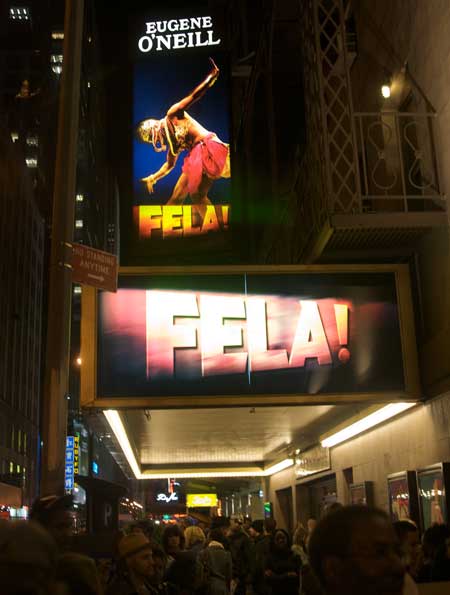Sean Barlow and Banning Eyre were lucky enough to attend the first public performance of Fela! The Musical at the Eugene O’Neil Theatre on October 19, 2009. The show went on to be a massive international success.
The first public performance of Fela! the musical on Broadway was automatically historic. When the Nigerian bandleader and creator of Afrobeat died in 1997, his place in his country’s pantheon of the arts was assured, and he commanded a cadre of fanatically loyal fans around the world. But few would have foreseen the way Fela’s reputation and stature would continue to grow, or the way young musicians in cities everywhere would be inspired to appropriate his brass-heavy uber-grooves and in-your-face political rants, adapting them to new times and places and making Afrobeat a durable genre for the ages. Fela! is perhaps the most persuasive evidence of Fela Anikulapo-Kuti’s still-accruing legacy. The fact that Bill T. Jones, Jim Lewis and Stephen Hendel were inspired to create a full-blown theater and dance piece based on Fela’s life and work was remarkable enough when it happened some two years ago. That the show did well enough Off Broadway to earn a run at the Eugene O’Neil amounts to a landmark event for African music in the American mainstream.
This show evokes, rather than dramatizes, Fela’s life. The onstage Fela, played with sunny brio by Sahr Ngaujah, tells the audience about his powerful, intellectually precocious and politically brave mother Funmilayo, about his jazz education in London, his discovery of black power in L.A., his early run-ins with the government back in Nigeria, the building of his nightclub The Shrine, and ultimately the 1977 raid on his compound that resulted in his mother’s death. Funmilayo and Fela’s L.A. girlfriend Sandra have singing roles, but engage in no real dialogue. They are figures more than fully drawn characters in the show. This puts a heavy burden on Fela himself to convey the show’s narrative backbone, a burden Ngaujah carries with remarkable ease. But the deeper story is not told in words or played out in set pieces. Rather, it emerges through music and dance.
The band—essentially the core of Brooklyn’s Antibalas Afrobeat Orchestra—plays as the audience enters. The musicians are on the stage, not hidden in a pit. This alone serves notice that Fela’s band will be a central player in the story to come. Both acts of the play open with Fela addressing the audience as though this were a performance at The Shrine. “Everybody say, ‘Yeah, yeah,” Fela entreats the audience at regular intervals, returning continually to this concert illusion. Excerpts from classic Fela songs (including “Teacher Don’t Teach Me Nonsense,” “International Thief Thief,” “Water No Get Enemy,” “Black President,” “Zombie,” “Sorrow Tears and Blood,” and “Coffin for Head of State”) intersperse the action throughout, underscoring the autobiographical aspect of Fela’s key works. In some cases, Fela’s pidgin English has been simplified for understandability. At times, his words are projected on one of the set’s embedded screens to make sure the meaning is not lost. This show puts a premium on letting the audience enter the deep meld of groove and attitude that lies at the heart of Fela’s Afrobeat.
Bill T. Jones’s choreography is a seamless blend of modern dance form and traditional African aesthetic. The ensemble includes some superb African dancers. Moments of out-and-out, flailing-arm-and-leg ecstasy feel absolutely authentic. At the same time the ensemble morphs and flows to support the action as it moves from the dancefloor at the Shrine, to the battle zone of the compound raid, and ultimately the mystic, ritual psychedelia of Funmilayo’s death—a surreal and transporting mélange of black lights, white costumes, ladders and projections on a transparent screen. (The entire set design is nothing short of dazzling.) The onstage movement is always complex and inventive, but also fluid, completely free of the awkwardness that can so easily attend Western presentations of African dance.
For all the information shoehorned into Fela’s narrative, this is of necessity an abridged telling of his tale. A scene where Fela scolds his drummer barely hints at the man’s notoriously mercurial approach to band leading. We see little of Fela’s dark side—his tempestuous anger, or his dismissal of AIDS as a genuine threat, for example. Fela’s story is deep, and extremely untidy. A more nuanced character study will have to wait for the dramatic, feature length film. The goal here is to open ears and eyes and to celebrate one of the most inspired and powerful bandleaders Africa has yet produced.
The first public run-through of Fela! on Broadway inevitably ran into a few glitches, particularly with ill-behaved cordless microphones. Still, there was no mistaking the show’s extraordinary vision, craft, and spirit, nor the irresistible vitality of all the performances. This first night audience included a number of people with direct experience of Fela during his lifetime, and they received the work with unmistakable excitement. There have been a number of adjustments to the show since its off-Broadway run, and they will continue during this month of previews. At the cast after-party, the players themselves seemed relieved and exhilarated to have made it all the way through in front of an audience at last. A visiting Nigerian lawyer expressed his hope that the show might one day play in Lagos. Before entertaining any such thought the Fela! team is focused on sustaining the longest possible Broadway run. As a point of reference, Sarafina!, an apartheid-era South African themed musical by Mbongeni Ngema, played at the Cort Theatre from January 1988 through July 1989. More than 20 years later, it’s Fela!’s time to shine.









